Cross-Cultural Communication: Business Challenges and Solutions
VerifiedAdded on 2020/06/04
|11
|3113
|43
Report
AI Summary
This report delves into the complexities of cross-cultural communication within a business context, specifically comparing the communication styles and cultural nuances of Australia and India. It explores cross-cultural communication as a business and ethical issue, highlighting the economic challenges that necessitate improved internal communication. The report defines cultural proficiency and contrasts approaches to cultural adaptation versus individual differences. It emphasizes the competitive advantages enjoyed by companies successful in cross-cultural communication, comparing communication styles and identifying potential misunderstandings and their negative impacts on business outcomes. The analysis covers various aspects of the business environment, including working hours, cultural relationships, and equal opportunity practices. The report provides insights into how to navigate cultural differences to foster effective communication, improve business outcomes, and build strong relationships in a globalized world.

CROSS CULTURAL
COMMUNICATION
COMMUNICATION
Paraphrase This Document
Need a fresh take? Get an instant paraphrase of this document with our AI Paraphraser

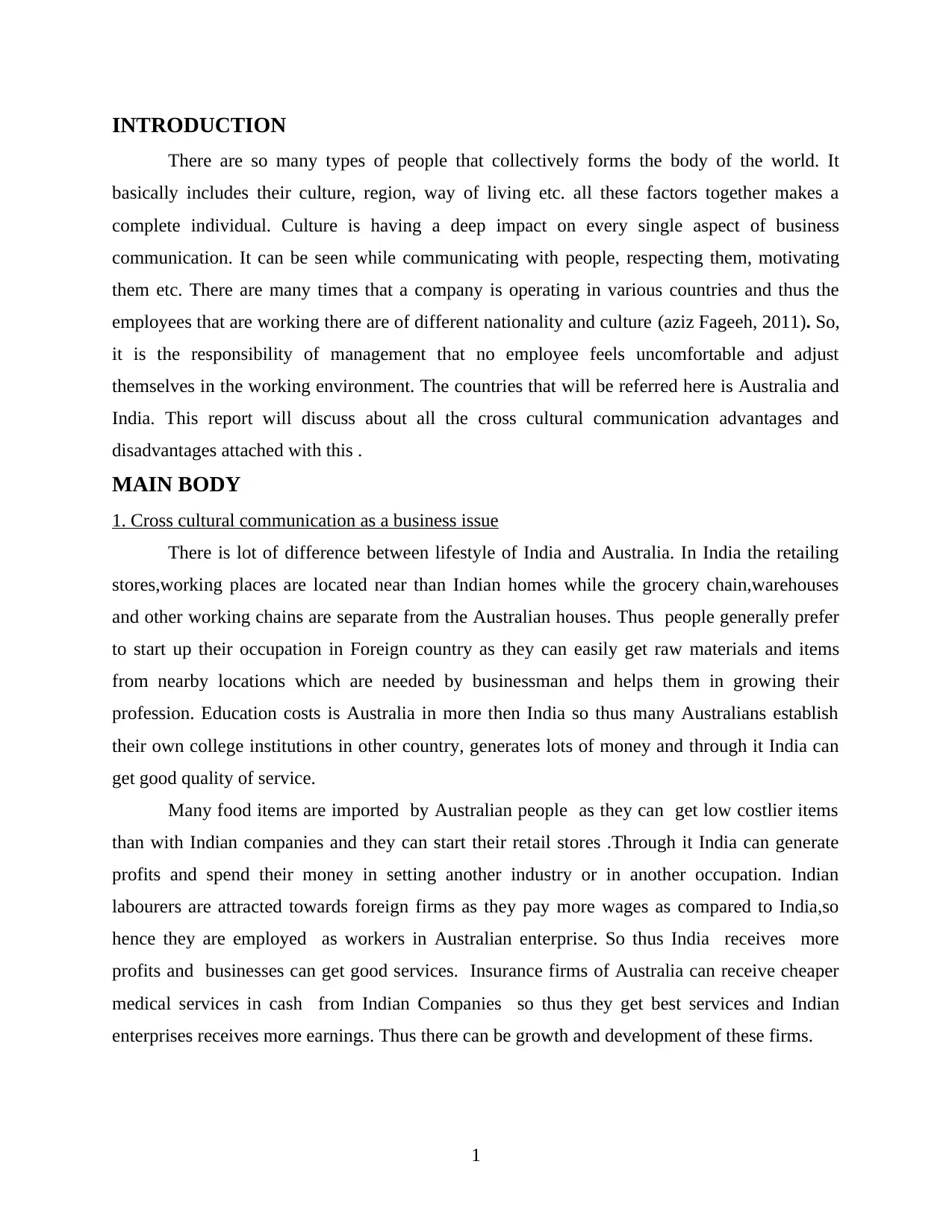
INTRODUCTION
There are so many types of people that collectively forms the body of the world. It
basically includes their culture, region, way of living etc. all these factors together makes a
complete individual. Culture is having a deep impact on every single aspect of business
communication. It can be seen while communicating with people, respecting them, motivating
them etc. There are many times that a company is operating in various countries and thus the
employees that are working there are of different nationality and culture (aziz Fageeh, 2011). So,
it is the responsibility of management that no employee feels uncomfortable and adjust
themselves in the working environment. The countries that will be referred here is Australia and
India. This report will discuss about all the cross cultural communication advantages and
disadvantages attached with this .
MAIN BODY
1. Cross cultural communication as a business issue
There is lot of difference between lifestyle of India and Australia. In India the retailing
stores,working places are located near than Indian homes while the grocery chain,warehouses
and other working chains are separate from the Australian houses. Thus people generally prefer
to start up their occupation in Foreign country as they can easily get raw materials and items
from nearby locations which are needed by businessman and helps them in growing their
profession. Education costs is Australia in more then India so thus many Australians establish
their own college institutions in other country, generates lots of money and through it India can
get good quality of service.
Many food items are imported by Australian people as they can get low costlier items
than with Indian companies and they can start their retail stores .Through it India can generate
profits and spend their money in setting another industry or in another occupation. Indian
labourers are attracted towards foreign firms as they pay more wages as compared to India,so
hence they are employed as workers in Australian enterprise. So thus India receives more
profits and businesses can get good services. Insurance firms of Australia can receive cheaper
medical services in cash from Indian Companies so thus they get best services and Indian
enterprises receives more earnings. Thus there can be growth and development of these firms.
1
There are so many types of people that collectively forms the body of the world. It
basically includes their culture, region, way of living etc. all these factors together makes a
complete individual. Culture is having a deep impact on every single aspect of business
communication. It can be seen while communicating with people, respecting them, motivating
them etc. There are many times that a company is operating in various countries and thus the
employees that are working there are of different nationality and culture (aziz Fageeh, 2011). So,
it is the responsibility of management that no employee feels uncomfortable and adjust
themselves in the working environment. The countries that will be referred here is Australia and
India. This report will discuss about all the cross cultural communication advantages and
disadvantages attached with this .
MAIN BODY
1. Cross cultural communication as a business issue
There is lot of difference between lifestyle of India and Australia. In India the retailing
stores,working places are located near than Indian homes while the grocery chain,warehouses
and other working chains are separate from the Australian houses. Thus people generally prefer
to start up their occupation in Foreign country as they can easily get raw materials and items
from nearby locations which are needed by businessman and helps them in growing their
profession. Education costs is Australia in more then India so thus many Australians establish
their own college institutions in other country, generates lots of money and through it India can
get good quality of service.
Many food items are imported by Australian people as they can get low costlier items
than with Indian companies and they can start their retail stores .Through it India can generate
profits and spend their money in setting another industry or in another occupation. Indian
labourers are attracted towards foreign firms as they pay more wages as compared to India,so
hence they are employed as workers in Australian enterprise. So thus India receives more
profits and businesses can get good services. Insurance firms of Australia can receive cheaper
medical services in cash from Indian Companies so thus they get best services and Indian
enterprises receives more earnings. Thus there can be growth and development of these firms.
1
⊘ This is a preview!⊘
Do you want full access?
Subscribe today to unlock all pages.

Trusted by 1+ million students worldwide
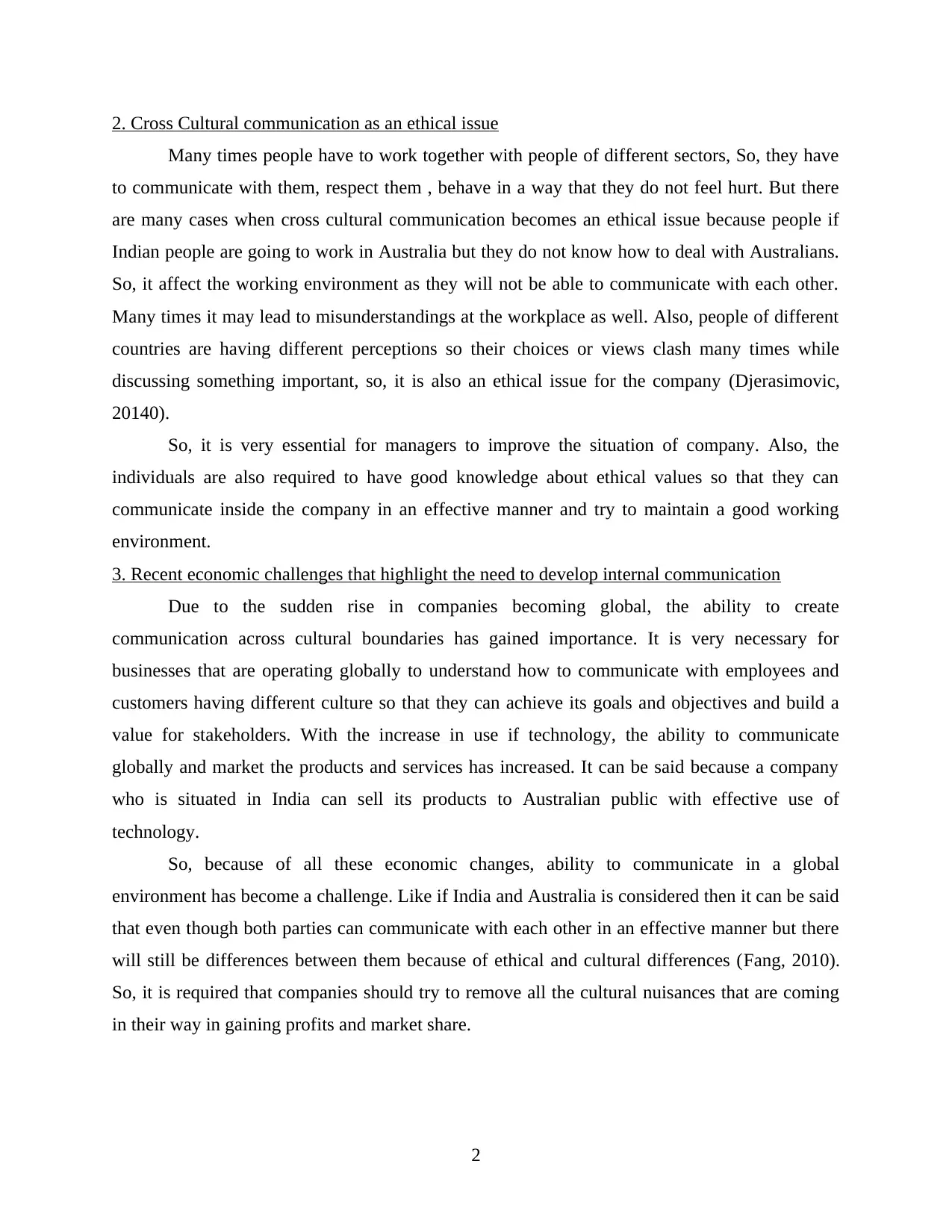
2. Cross Cultural communication as an ethical issue
Many times people have to work together with people of different sectors, So, they have
to communicate with them, respect them , behave in a way that they do not feel hurt. But there
are many cases when cross cultural communication becomes an ethical issue because people if
Indian people are going to work in Australia but they do not know how to deal with Australians.
So, it affect the working environment as they will not be able to communicate with each other.
Many times it may lead to misunderstandings at the workplace as well. Also, people of different
countries are having different perceptions so their choices or views clash many times while
discussing something important, so, it is also an ethical issue for the company (Djerasimovic,
20140).
So, it is very essential for managers to improve the situation of company. Also, the
individuals are also required to have good knowledge about ethical values so that they can
communicate inside the company in an effective manner and try to maintain a good working
environment.
3. Recent economic challenges that highlight the need to develop internal communication
Due to the sudden rise in companies becoming global, the ability to create
communication across cultural boundaries has gained importance. It is very necessary for
businesses that are operating globally to understand how to communicate with employees and
customers having different culture so that they can achieve its goals and objectives and build a
value for stakeholders. With the increase in use if technology, the ability to communicate
globally and market the products and services has increased. It can be said because a company
who is situated in India can sell its products to Australian public with effective use of
technology.
So, because of all these economic changes, ability to communicate in a global
environment has become a challenge. Like if India and Australia is considered then it can be said
that even though both parties can communicate with each other in an effective manner but there
will still be differences between them because of ethical and cultural differences (Fang, 2010).
So, it is required that companies should try to remove all the cultural nuisances that are coming
in their way in gaining profits and market share.
2
Many times people have to work together with people of different sectors, So, they have
to communicate with them, respect them , behave in a way that they do not feel hurt. But there
are many cases when cross cultural communication becomes an ethical issue because people if
Indian people are going to work in Australia but they do not know how to deal with Australians.
So, it affect the working environment as they will not be able to communicate with each other.
Many times it may lead to misunderstandings at the workplace as well. Also, people of different
countries are having different perceptions so their choices or views clash many times while
discussing something important, so, it is also an ethical issue for the company (Djerasimovic,
20140).
So, it is very essential for managers to improve the situation of company. Also, the
individuals are also required to have good knowledge about ethical values so that they can
communicate inside the company in an effective manner and try to maintain a good working
environment.
3. Recent economic challenges that highlight the need to develop internal communication
Due to the sudden rise in companies becoming global, the ability to create
communication across cultural boundaries has gained importance. It is very necessary for
businesses that are operating globally to understand how to communicate with employees and
customers having different culture so that they can achieve its goals and objectives and build a
value for stakeholders. With the increase in use if technology, the ability to communicate
globally and market the products and services has increased. It can be said because a company
who is situated in India can sell its products to Australian public with effective use of
technology.
So, because of all these economic changes, ability to communicate in a global
environment has become a challenge. Like if India and Australia is considered then it can be said
that even though both parties can communicate with each other in an effective manner but there
will still be differences between them because of ethical and cultural differences (Fang, 2010).
So, it is required that companies should try to remove all the cultural nuisances that are coming
in their way in gaining profits and market share.
2
Paraphrase This Document
Need a fresh take? Get an instant paraphrase of this document with our AI Paraphraser
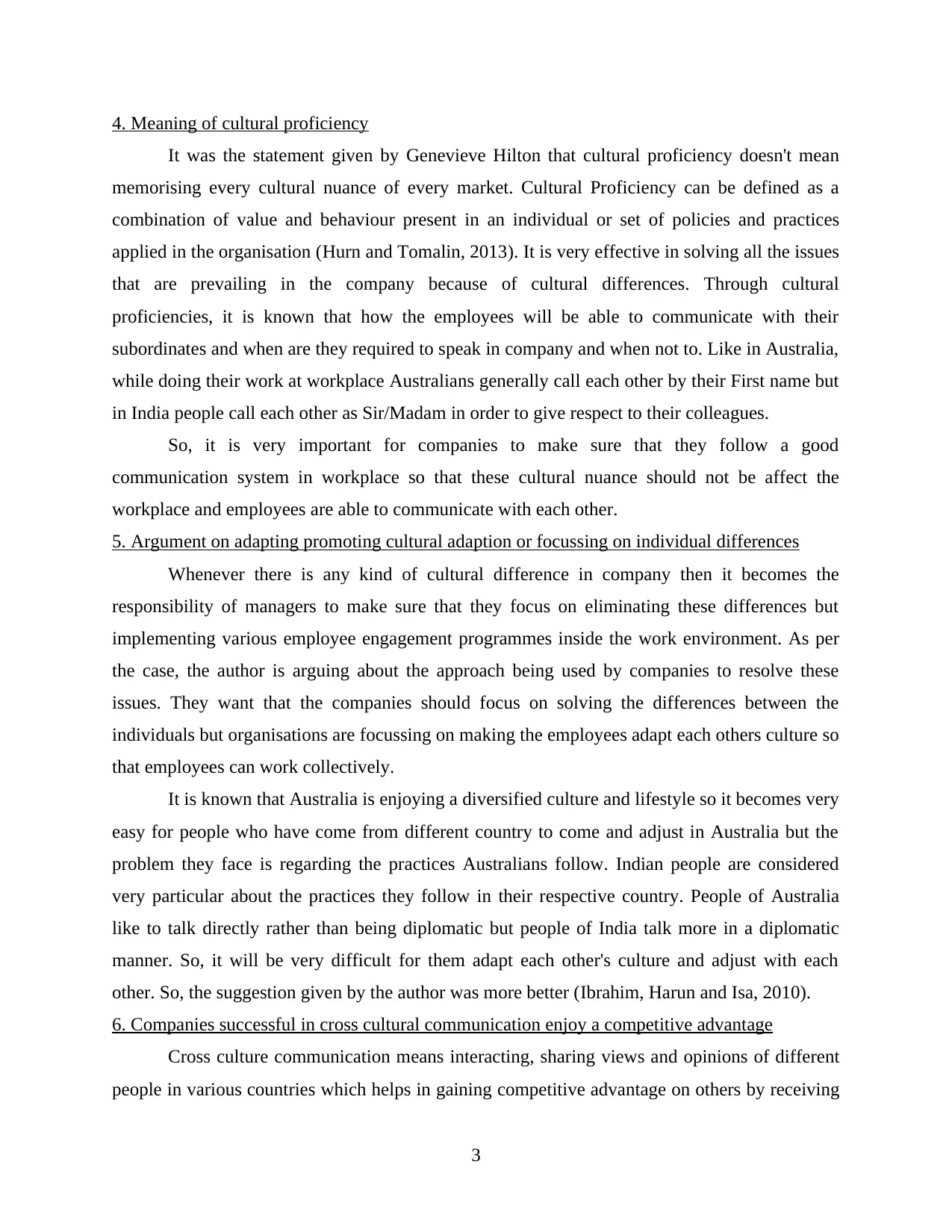
4. Meaning of cultural proficiency
It was the statement given by Genevieve Hilton that cultural proficiency doesn't mean
memorising every cultural nuance of every market. Cultural Proficiency can be defined as a
combination of value and behaviour present in an individual or set of policies and practices
applied in the organisation (Hurn and Tomalin, 2013). It is very effective in solving all the issues
that are prevailing in the company because of cultural differences. Through cultural
proficiencies, it is known that how the employees will be able to communicate with their
subordinates and when are they required to speak in company and when not to. Like in Australia,
while doing their work at workplace Australians generally call each other by their First name but
in India people call each other as Sir/Madam in order to give respect to their colleagues.
So, it is very important for companies to make sure that they follow a good
communication system in workplace so that these cultural nuance should not be affect the
workplace and employees are able to communicate with each other.
5. Argument on adapting promoting cultural adaption or focussing on individual differences
Whenever there is any kind of cultural difference in company then it becomes the
responsibility of managers to make sure that they focus on eliminating these differences but
implementing various employee engagement programmes inside the work environment. As per
the case, the author is arguing about the approach being used by companies to resolve these
issues. They want that the companies should focus on solving the differences between the
individuals but organisations are focussing on making the employees adapt each others culture so
that employees can work collectively.
It is known that Australia is enjoying a diversified culture and lifestyle so it becomes very
easy for people who have come from different country to come and adjust in Australia but the
problem they face is regarding the practices Australians follow. Indian people are considered
very particular about the practices they follow in their respective country. People of Australia
like to talk directly rather than being diplomatic but people of India talk more in a diplomatic
manner. So, it will be very difficult for them adapt each other's culture and adjust with each
other. So, the suggestion given by the author was more better (Ibrahim, Harun and Isa, 2010).
6. Companies successful in cross cultural communication enjoy a competitive advantage
Cross culture communication means interacting, sharing views and opinions of different
people in various countries which helps in gaining competitive advantage on others by receiving
3
It was the statement given by Genevieve Hilton that cultural proficiency doesn't mean
memorising every cultural nuance of every market. Cultural Proficiency can be defined as a
combination of value and behaviour present in an individual or set of policies and practices
applied in the organisation (Hurn and Tomalin, 2013). It is very effective in solving all the issues
that are prevailing in the company because of cultural differences. Through cultural
proficiencies, it is known that how the employees will be able to communicate with their
subordinates and when are they required to speak in company and when not to. Like in Australia,
while doing their work at workplace Australians generally call each other by their First name but
in India people call each other as Sir/Madam in order to give respect to their colleagues.
So, it is very important for companies to make sure that they follow a good
communication system in workplace so that these cultural nuance should not be affect the
workplace and employees are able to communicate with each other.
5. Argument on adapting promoting cultural adaption or focussing on individual differences
Whenever there is any kind of cultural difference in company then it becomes the
responsibility of managers to make sure that they focus on eliminating these differences but
implementing various employee engagement programmes inside the work environment. As per
the case, the author is arguing about the approach being used by companies to resolve these
issues. They want that the companies should focus on solving the differences between the
individuals but organisations are focussing on making the employees adapt each others culture so
that employees can work collectively.
It is known that Australia is enjoying a diversified culture and lifestyle so it becomes very
easy for people who have come from different country to come and adjust in Australia but the
problem they face is regarding the practices Australians follow. Indian people are considered
very particular about the practices they follow in their respective country. People of Australia
like to talk directly rather than being diplomatic but people of India talk more in a diplomatic
manner. So, it will be very difficult for them adapt each other's culture and adjust with each
other. So, the suggestion given by the author was more better (Ibrahim, Harun and Isa, 2010).
6. Companies successful in cross cultural communication enjoy a competitive advantage
Cross culture communication means interacting, sharing views and opinions of different
people in various countries which helps in gaining competitive advantage on others by receiving
3
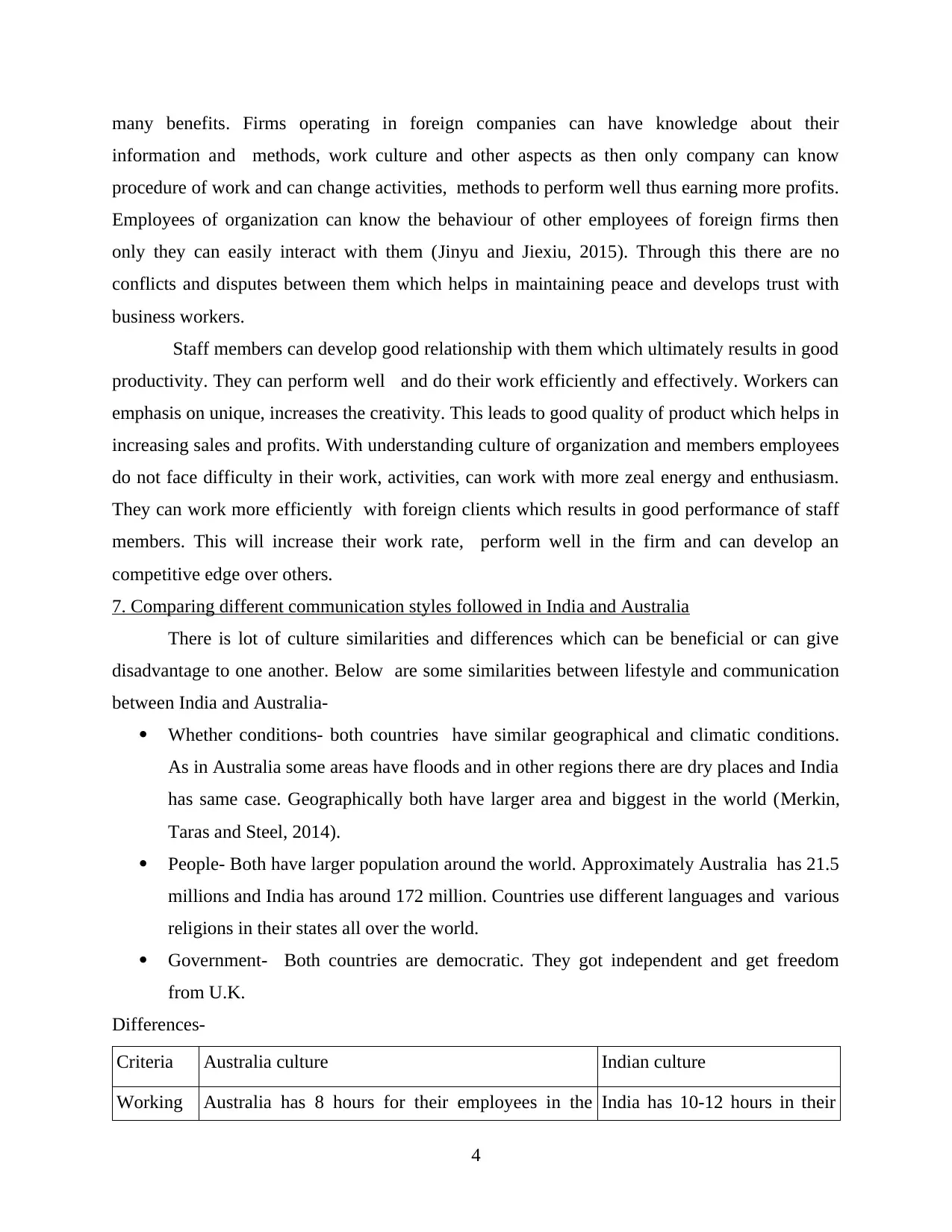
many benefits. Firms operating in foreign companies can have knowledge about their
information and methods, work culture and other aspects as then only company can know
procedure of work and can change activities, methods to perform well thus earning more profits.
Employees of organization can know the behaviour of other employees of foreign firms then
only they can easily interact with them (Jinyu and Jiexiu, 2015). Through this there are no
conflicts and disputes between them which helps in maintaining peace and develops trust with
business workers.
Staff members can develop good relationship with them which ultimately results in good
productivity. They can perform well and do their work efficiently and effectively. Workers can
emphasis on unique, increases the creativity. This leads to good quality of product which helps in
increasing sales and profits. With understanding culture of organization and members employees
do not face difficulty in their work, activities, can work with more zeal energy and enthusiasm.
They can work more efficiently with foreign clients which results in good performance of staff
members. This will increase their work rate, perform well in the firm and can develop an
competitive edge over others.
7. Comparing different communication styles followed in India and Australia
There is lot of culture similarities and differences which can be beneficial or can give
disadvantage to one another. Below are some similarities between lifestyle and communication
between India and Australia-
Whether conditions- both countries have similar geographical and climatic conditions.
As in Australia some areas have floods and in other regions there are dry places and India
has same case. Geographically both have larger area and biggest in the world (Merkin,
Taras and Steel, 2014).
People- Both have larger population around the world. Approximately Australia has 21.5
millions and India has around 172 million. Countries use different languages and various
religions in their states all over the world.
Government- Both countries are democratic. They got independent and get freedom
from U.K.
Differences-
Criteria Australia culture Indian culture
Working Australia has 8 hours for their employees in the India has 10-12 hours in their
4
information and methods, work culture and other aspects as then only company can know
procedure of work and can change activities, methods to perform well thus earning more profits.
Employees of organization can know the behaviour of other employees of foreign firms then
only they can easily interact with them (Jinyu and Jiexiu, 2015). Through this there are no
conflicts and disputes between them which helps in maintaining peace and develops trust with
business workers.
Staff members can develop good relationship with them which ultimately results in good
productivity. They can perform well and do their work efficiently and effectively. Workers can
emphasis on unique, increases the creativity. This leads to good quality of product which helps in
increasing sales and profits. With understanding culture of organization and members employees
do not face difficulty in their work, activities, can work with more zeal energy and enthusiasm.
They can work more efficiently with foreign clients which results in good performance of staff
members. This will increase their work rate, perform well in the firm and can develop an
competitive edge over others.
7. Comparing different communication styles followed in India and Australia
There is lot of culture similarities and differences which can be beneficial or can give
disadvantage to one another. Below are some similarities between lifestyle and communication
between India and Australia-
Whether conditions- both countries have similar geographical and climatic conditions.
As in Australia some areas have floods and in other regions there are dry places and India
has same case. Geographically both have larger area and biggest in the world (Merkin,
Taras and Steel, 2014).
People- Both have larger population around the world. Approximately Australia has 21.5
millions and India has around 172 million. Countries use different languages and various
religions in their states all over the world.
Government- Both countries are democratic. They got independent and get freedom
from U.K.
Differences-
Criteria Australia culture Indian culture
Working Australia has 8 hours for their employees in the India has 10-12 hours in their
4
⊘ This is a preview!⊘
Do you want full access?
Subscribe today to unlock all pages.

Trusted by 1+ million students worldwide
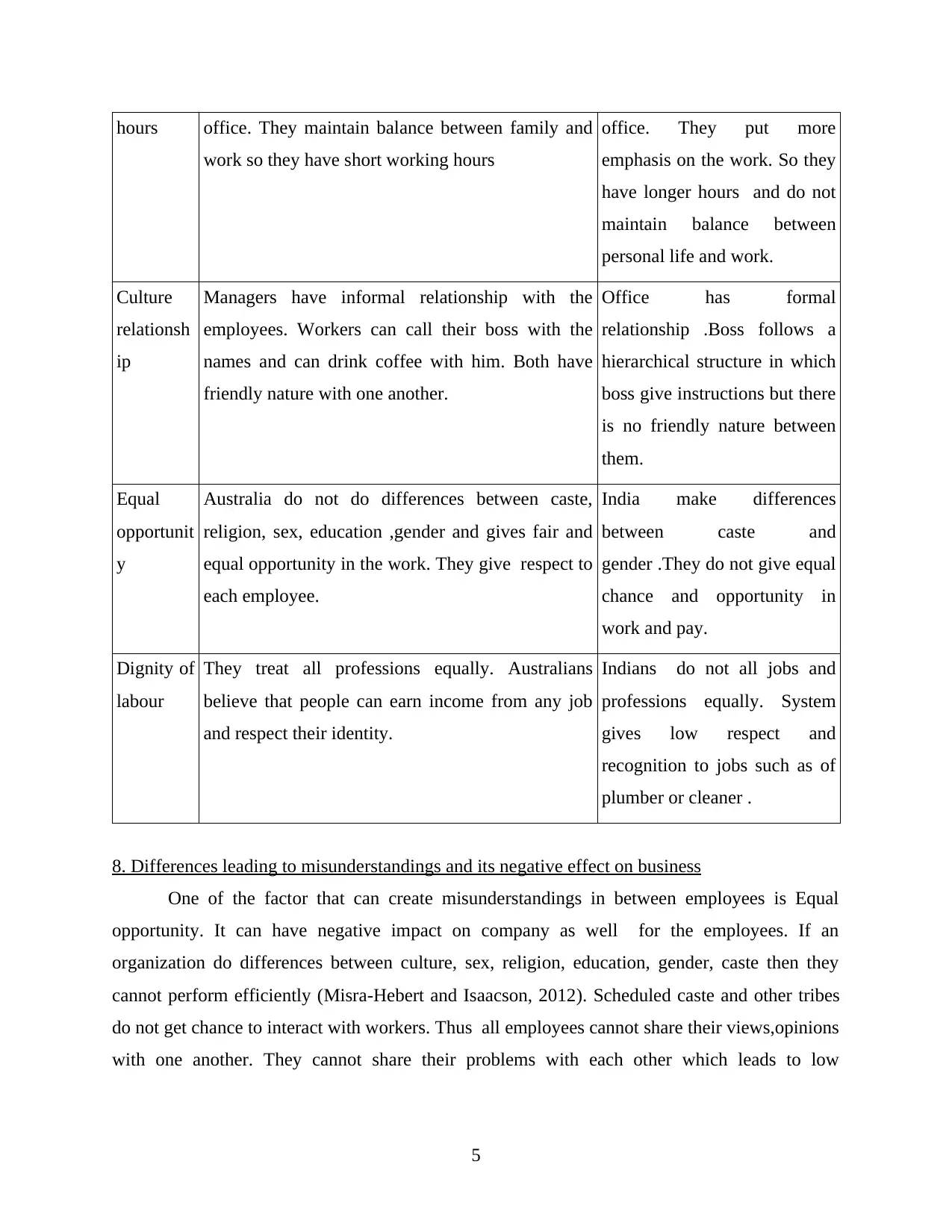
hours office. They maintain balance between family and
work so they have short working hours
office. They put more
emphasis on the work. So they
have longer hours and do not
maintain balance between
personal life and work.
Culture
relationsh
ip
Managers have informal relationship with the
employees. Workers can call their boss with the
names and can drink coffee with him. Both have
friendly nature with one another.
Office has formal
relationship .Boss follows a
hierarchical structure in which
boss give instructions but there
is no friendly nature between
them.
Equal
opportunit
y
Australia do not do differences between caste,
religion, sex, education ,gender and gives fair and
equal opportunity in the work. They give respect to
each employee.
India make differences
between caste and
gender .They do not give equal
chance and opportunity in
work and pay.
Dignity of
labour
They treat all professions equally. Australians
believe that people can earn income from any job
and respect their identity.
Indians do not all jobs and
professions equally. System
gives low respect and
recognition to jobs such as of
plumber or cleaner .
8. Differences leading to misunderstandings and its negative effect on business
One of the factor that can create misunderstandings in between employees is Equal
opportunity. It can have negative impact on company as well for the employees. If an
organization do differences between culture, sex, religion, education, gender, caste then they
cannot perform efficiently (Misra-Hebert and Isaacson, 2012). Scheduled caste and other tribes
do not get chance to interact with workers. Thus all employees cannot share their views,opinions
with one another. They cannot share their problems with each other which leads to low
5
work so they have short working hours
office. They put more
emphasis on the work. So they
have longer hours and do not
maintain balance between
personal life and work.
Culture
relationsh
ip
Managers have informal relationship with the
employees. Workers can call their boss with the
names and can drink coffee with him. Both have
friendly nature with one another.
Office has formal
relationship .Boss follows a
hierarchical structure in which
boss give instructions but there
is no friendly nature between
them.
Equal
opportunit
y
Australia do not do differences between caste,
religion, sex, education ,gender and gives fair and
equal opportunity in the work. They give respect to
each employee.
India make differences
between caste and
gender .They do not give equal
chance and opportunity in
work and pay.
Dignity of
labour
They treat all professions equally. Australians
believe that people can earn income from any job
and respect their identity.
Indians do not all jobs and
professions equally. System
gives low respect and
recognition to jobs such as of
plumber or cleaner .
8. Differences leading to misunderstandings and its negative effect on business
One of the factor that can create misunderstandings in between employees is Equal
opportunity. It can have negative impact on company as well for the employees. If an
organization do differences between culture, sex, religion, education, gender, caste then they
cannot perform efficiently (Misra-Hebert and Isaacson, 2012). Scheduled caste and other tribes
do not get chance to interact with workers. Thus all employees cannot share their views,opinions
with one another. They cannot share their problems with each other which leads to low
5
Paraphrase This Document
Need a fresh take? Get an instant paraphrase of this document with our AI Paraphraser
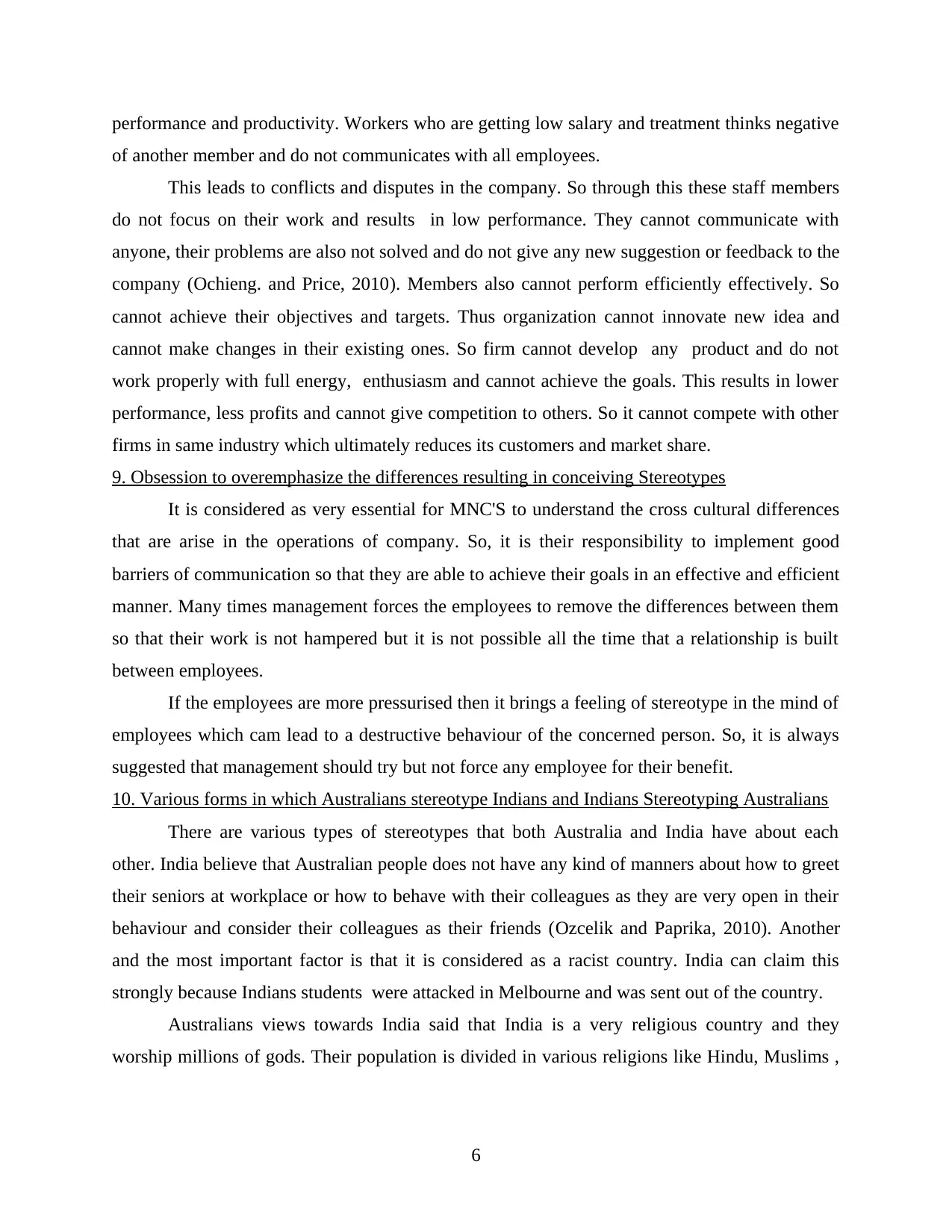
performance and productivity. Workers who are getting low salary and treatment thinks negative
of another member and do not communicates with all employees.
This leads to conflicts and disputes in the company. So through this these staff members
do not focus on their work and results in low performance. They cannot communicate with
anyone, their problems are also not solved and do not give any new suggestion or feedback to the
company (Ochieng. and Price, 2010). Members also cannot perform efficiently effectively. So
cannot achieve their objectives and targets. Thus organization cannot innovate new idea and
cannot make changes in their existing ones. So firm cannot develop any product and do not
work properly with full energy, enthusiasm and cannot achieve the goals. This results in lower
performance, less profits and cannot give competition to others. So it cannot compete with other
firms in same industry which ultimately reduces its customers and market share.
9. Obsession to overemphasize the differences resulting in conceiving Stereotypes
It is considered as very essential for MNC'S to understand the cross cultural differences
that are arise in the operations of company. So, it is their responsibility to implement good
barriers of communication so that they are able to achieve their goals in an effective and efficient
manner. Many times management forces the employees to remove the differences between them
so that their work is not hampered but it is not possible all the time that a relationship is built
between employees.
If the employees are more pressurised then it brings a feeling of stereotype in the mind of
employees which cam lead to a destructive behaviour of the concerned person. So, it is always
suggested that management should try but not force any employee for their benefit.
10. Various forms in which Australians stereotype Indians and Indians Stereotyping Australians
There are various types of stereotypes that both Australia and India have about each
other. India believe that Australian people does not have any kind of manners about how to greet
their seniors at workplace or how to behave with their colleagues as they are very open in their
behaviour and consider their colleagues as their friends (Ozcelik and Paprika, 2010). Another
and the most important factor is that it is considered as a racist country. India can claim this
strongly because Indians students were attacked in Melbourne and was sent out of the country.
Australians views towards India said that India is a very religious country and they
worship millions of gods. Their population is divided in various religions like Hindu, Muslims ,
6
of another member and do not communicates with all employees.
This leads to conflicts and disputes in the company. So through this these staff members
do not focus on their work and results in low performance. They cannot communicate with
anyone, their problems are also not solved and do not give any new suggestion or feedback to the
company (Ochieng. and Price, 2010). Members also cannot perform efficiently effectively. So
cannot achieve their objectives and targets. Thus organization cannot innovate new idea and
cannot make changes in their existing ones. So firm cannot develop any product and do not
work properly with full energy, enthusiasm and cannot achieve the goals. This results in lower
performance, less profits and cannot give competition to others. So it cannot compete with other
firms in same industry which ultimately reduces its customers and market share.
9. Obsession to overemphasize the differences resulting in conceiving Stereotypes
It is considered as very essential for MNC'S to understand the cross cultural differences
that are arise in the operations of company. So, it is their responsibility to implement good
barriers of communication so that they are able to achieve their goals in an effective and efficient
manner. Many times management forces the employees to remove the differences between them
so that their work is not hampered but it is not possible all the time that a relationship is built
between employees.
If the employees are more pressurised then it brings a feeling of stereotype in the mind of
employees which cam lead to a destructive behaviour of the concerned person. So, it is always
suggested that management should try but not force any employee for their benefit.
10. Various forms in which Australians stereotype Indians and Indians Stereotyping Australians
There are various types of stereotypes that both Australia and India have about each
other. India believe that Australian people does not have any kind of manners about how to greet
their seniors at workplace or how to behave with their colleagues as they are very open in their
behaviour and consider their colleagues as their friends (Ozcelik and Paprika, 2010). Another
and the most important factor is that it is considered as a racist country. India can claim this
strongly because Indians students were attacked in Melbourne and was sent out of the country.
Australians views towards India said that India is a very religious country and they
worship millions of gods. Their population is divided in various religions like Hindu, Muslims ,
6
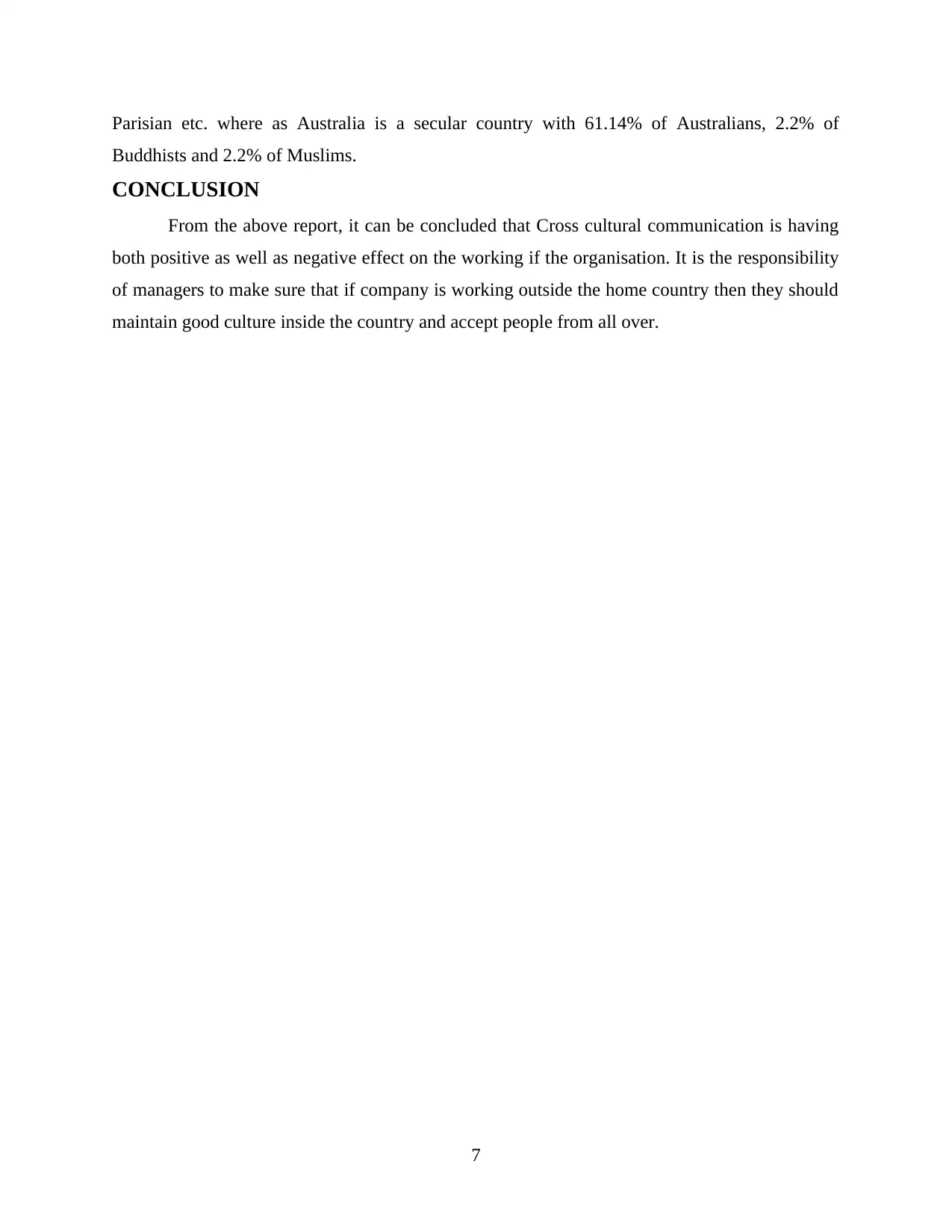
Parisian etc. where as Australia is a secular country with 61.14% of Australians, 2.2% of
Buddhists and 2.2% of Muslims.
CONCLUSION
From the above report, it can be concluded that Cross cultural communication is having
both positive as well as negative effect on the working if the organisation. It is the responsibility
of managers to make sure that if company is working outside the home country then they should
maintain good culture inside the country and accept people from all over.
7
Buddhists and 2.2% of Muslims.
CONCLUSION
From the above report, it can be concluded that Cross cultural communication is having
both positive as well as negative effect on the working if the organisation. It is the responsibility
of managers to make sure that if company is working outside the home country then they should
maintain good culture inside the country and accept people from all over.
7
⊘ This is a preview!⊘
Do you want full access?
Subscribe today to unlock all pages.

Trusted by 1+ million students worldwide
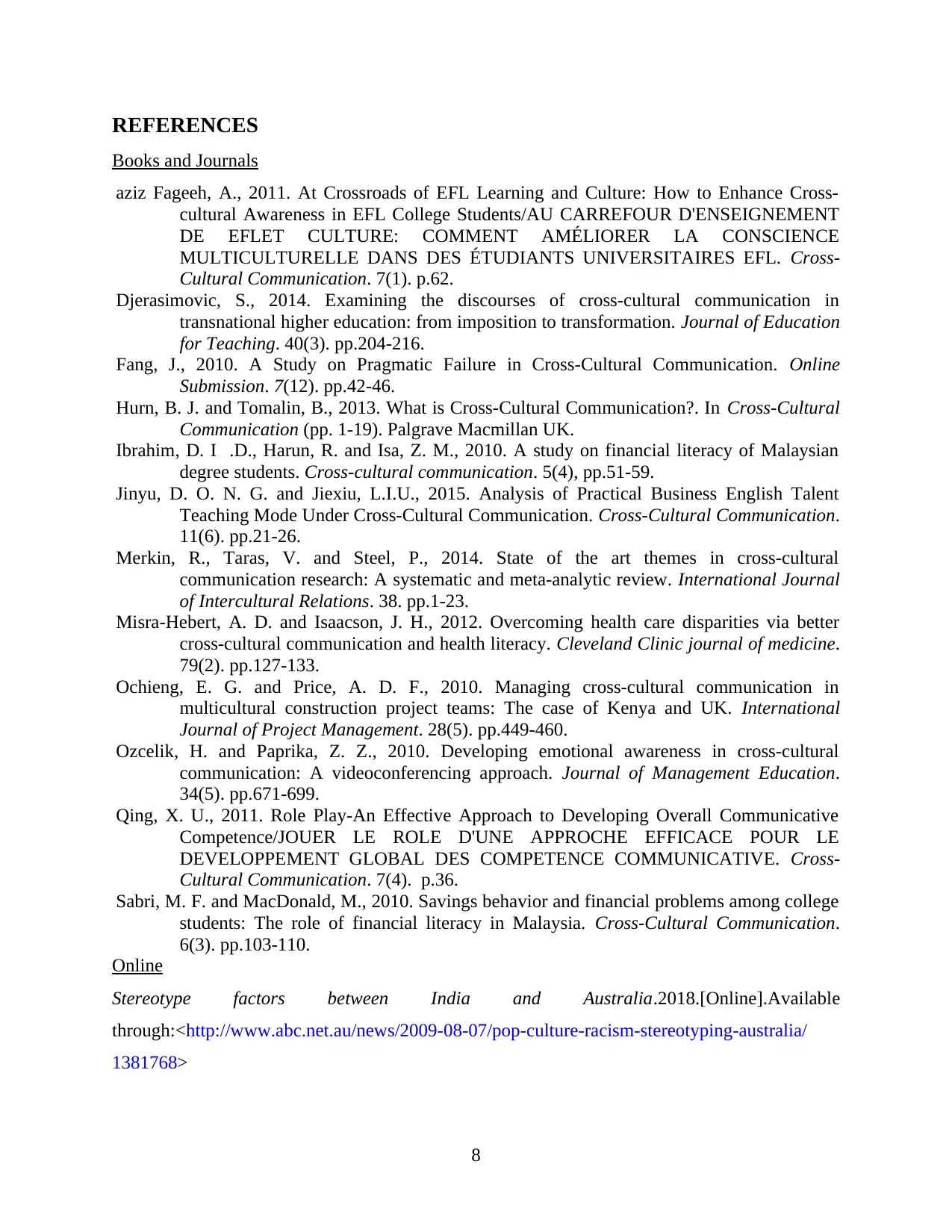
REFERENCES
Books and Journals
aziz Fageeh, A., 2011. At Crossroads of EFL Learning and Culture: How to Enhance Cross-
cultural Awareness in EFL College Students/AU CARREFOUR D'ENSEIGNEMENT
DE EFLET CULTURE: COMMENT AMÉLIORER LA CONSCIENCE
MULTICULTURELLE DANS DES ÉTUDIANTS UNIVERSITAIRES EFL. Cross-
Cultural Communication. 7(1). p.62.
Djerasimovic, S., 2014. Examining the discourses of cross-cultural communication in
transnational higher education: from imposition to transformation. Journal of Education
for Teaching. 40(3). pp.204-216.
Fang, J., 2010. A Study on Pragmatic Failure in Cross-Cultural Communication. Online
Submission. 7(12). pp.42-46.
Hurn, B. J. and Tomalin, B., 2013. What is Cross-Cultural Communication?. In Cross-Cultural
Communication (pp. 1-19). Palgrave Macmillan UK.
Ibrahim, D. I .D., Harun, R. and Isa, Z. M., 2010. A study on financial literacy of Malaysian
degree students. Cross-cultural communication. 5(4), pp.51-59.
Jinyu, D. O. N. G. and Jiexiu, L.I.U., 2015. Analysis of Practical Business English Talent
Teaching Mode Under Cross-Cultural Communication. Cross-Cultural Communication.
11(6). pp.21-26.
Merkin, R., Taras, V. and Steel, P., 2014. State of the art themes in cross-cultural
communication research: A systematic and meta-analytic review. International Journal
of Intercultural Relations. 38. pp.1-23.
Misra-Hebert, A. D. and Isaacson, J. H., 2012. Overcoming health care disparities via better
cross-cultural communication and health literacy. Cleveland Clinic journal of medicine.
79(2). pp.127-133.
Ochieng, E. G. and Price, A. D. F., 2010. Managing cross-cultural communication in
multicultural construction project teams: The case of Kenya and UK. International
Journal of Project Management. 28(5). pp.449-460.
Ozcelik, H. and Paprika, Z. Z., 2010. Developing emotional awareness in cross-cultural
communication: A videoconferencing approach. Journal of Management Education.
34(5). pp.671-699.
Qing, X. U., 2011. Role Play-An Effective Approach to Developing Overall Communicative
Competence/JOUER LE ROLE D'UNE APPROCHE EFFICACE POUR LE
DEVELOPPEMENT GLOBAL DES COMPETENCE COMMUNICATIVE. Cross-
Cultural Communication. 7(4). p.36.
Sabri, M. F. and MacDonald, M., 2010. Savings behavior and financial problems among college
students: The role of financial literacy in Malaysia. Cross-Cultural Communication.
6(3). pp.103-110.
Online
Stereotype factors between India and Australia.2018.[Online].Available
through:<http://www.abc.net.au/news/2009-08-07/pop-culture-racism-stereotyping-australia/
1381768>
8
Books and Journals
aziz Fageeh, A., 2011. At Crossroads of EFL Learning and Culture: How to Enhance Cross-
cultural Awareness in EFL College Students/AU CARREFOUR D'ENSEIGNEMENT
DE EFLET CULTURE: COMMENT AMÉLIORER LA CONSCIENCE
MULTICULTURELLE DANS DES ÉTUDIANTS UNIVERSITAIRES EFL. Cross-
Cultural Communication. 7(1). p.62.
Djerasimovic, S., 2014. Examining the discourses of cross-cultural communication in
transnational higher education: from imposition to transformation. Journal of Education
for Teaching. 40(3). pp.204-216.
Fang, J., 2010. A Study on Pragmatic Failure in Cross-Cultural Communication. Online
Submission. 7(12). pp.42-46.
Hurn, B. J. and Tomalin, B., 2013. What is Cross-Cultural Communication?. In Cross-Cultural
Communication (pp. 1-19). Palgrave Macmillan UK.
Ibrahim, D. I .D., Harun, R. and Isa, Z. M., 2010. A study on financial literacy of Malaysian
degree students. Cross-cultural communication. 5(4), pp.51-59.
Jinyu, D. O. N. G. and Jiexiu, L.I.U., 2015. Analysis of Practical Business English Talent
Teaching Mode Under Cross-Cultural Communication. Cross-Cultural Communication.
11(6). pp.21-26.
Merkin, R., Taras, V. and Steel, P., 2014. State of the art themes in cross-cultural
communication research: A systematic and meta-analytic review. International Journal
of Intercultural Relations. 38. pp.1-23.
Misra-Hebert, A. D. and Isaacson, J. H., 2012. Overcoming health care disparities via better
cross-cultural communication and health literacy. Cleveland Clinic journal of medicine.
79(2). pp.127-133.
Ochieng, E. G. and Price, A. D. F., 2010. Managing cross-cultural communication in
multicultural construction project teams: The case of Kenya and UK. International
Journal of Project Management. 28(5). pp.449-460.
Ozcelik, H. and Paprika, Z. Z., 2010. Developing emotional awareness in cross-cultural
communication: A videoconferencing approach. Journal of Management Education.
34(5). pp.671-699.
Qing, X. U., 2011. Role Play-An Effective Approach to Developing Overall Communicative
Competence/JOUER LE ROLE D'UNE APPROCHE EFFICACE POUR LE
DEVELOPPEMENT GLOBAL DES COMPETENCE COMMUNICATIVE. Cross-
Cultural Communication. 7(4). p.36.
Sabri, M. F. and MacDonald, M., 2010. Savings behavior and financial problems among college
students: The role of financial literacy in Malaysia. Cross-Cultural Communication.
6(3). pp.103-110.
Online
Stereotype factors between India and Australia.2018.[Online].Available
through:<http://www.abc.net.au/news/2009-08-07/pop-culture-racism-stereotyping-australia/
1381768>
8
Paraphrase This Document
Need a fresh take? Get an instant paraphrase of this document with our AI Paraphraser

aziz Fageeh, 2011Djerasimovic, 2014Fang, 2010Hurn and Tomalin, 2013Ibrahim, Harun and
Isa, 2010Jinyu and Jiexiu, 2015Merkin, Taras and Steel, 2014Misra-Hebert and
Isaacson, 2012Ochieng. and Price, 2010Ozcelik and Paprika, 2010Qing, 2011Sabri,
and MacDonald, 2010
9
Isa, 2010Jinyu and Jiexiu, 2015Merkin, Taras and Steel, 2014Misra-Hebert and
Isaacson, 2012Ochieng. and Price, 2010Ozcelik and Paprika, 2010Qing, 2011Sabri,
and MacDonald, 2010
9
1 out of 11
Related Documents
Your All-in-One AI-Powered Toolkit for Academic Success.
+13062052269
info@desklib.com
Available 24*7 on WhatsApp / Email
![[object Object]](/_next/static/media/star-bottom.7253800d.svg)
Unlock your academic potential
Copyright © 2020–2025 A2Z Services. All Rights Reserved. Developed and managed by ZUCOL.





